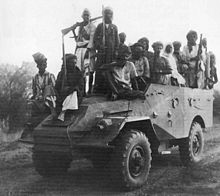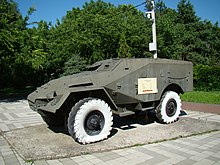BTR-40
The first was armed with two coaxial 14.5 mm KPVT heavy machine guns on a rotatable mount which was protected by armour plate at the front and sides.[citation needed] The vehicle's drawbacks, such as its poor cross-country performance and problems with crossing water obstacles, compelled the design team to produce, in late 1954, what was planned to be an amphibious variant of the BTR-40.The vehicle has no roof and is normally covered with a tarpaulin to protect the crew, transported cargo or troops from rain and snow.The APC variant has no permanent armament but it has pintle mounts for three 7.62 mm SGMB medium machine guns, one at the front of the troop compartment and the other two at the sides.The turning angle is 7.5 m. The vehicle has the 10RT-12 receiving and airing radio which has a range of 20–25 km and a winch at the front, with a maximum capacity of 4.5 tonnes and 70 m of cable.The BTR-40 began to enter service with two other Warsaw Pact members in late 1949, namely East Germany and Poland, where it was used as a standard APC until more advanced vehicles like the BTR-152 were available.The vehicle was also exported to North Korea, probably as part of a military assistance programme during the Korean War, where it saw combat for the first time.




Current
Former

Armoured Personnel CarrierReconnaissancevehicleSoviet UnionGorkovsky Avtomobilny Zavodmachine gunleaf springBronetransporterSovietreconnaissance vehicleBTR-152BRDM-1Gorky Automobile FactoryGAZ-63GAZ-12 ZIMsmall armsHungarian Uprising of 1956North Yemen Civil WarKorean WarVietnam WarHungarian Revolution of 1956Operation TrikoraSouth African Border WarSix-Day WarSoviet invasion of CzechoslovakiaSino-Soviet border conflictCambodian Civil WarYom Kippur WarEthiopian Civil WarEritrean War for IndependenceLebanese Civil WarWestern Sahara WarAngolan Civil WarOgaden WarChadian–Libyan conflictSoviet–Afghan WarIran-Iraq War1982 Ethiopian–Somali Border WarInsurgency in Acehroad–rail vehicleKPV heavy machine gunsChinese9M14 MalyutkaM1919A4BurundiGuineaGuinea-BissauIndonesiaNorth KoreaTanzaniaVietnamAngolaAfghanistanAlbaniaAlgeriaBotswanaPeople's Republic of BulgariaCambodiaPeople's Republic of ChinaPeople's Republic of the CongoEast GermanyEstoniaEstonian Defence LeagueHungarian People's RepublicIsraelIsrael Border PoliceMongolian People's RepublicMozambiquePolish People's RepublicSomaliaUgandaNorth YemenSouth YemenYugoslaviaCentral Intelligence AgencyInternational Institute for Strategic Studiesinfantry fighting vehiclesarmoured personnel carriersArmored car Scout carArmoured reconnaissanceABC-79MAPR-1VAkrep IIAravisAV-VB4BastionBPM-97BuffelUnicornBulletBurraqBushmasterCashuatCasspirMahindra MPV-IChaimiteCheetah MMPVCM6614Cobra IICockerill i-XCommandoCondorCougarCrocodileCSK-181Didgori-1Didgori-2Dragoon 300First WinGazelleAcademi GrizzlyGrizzlyHunter TR-12IgirigiK151 RaycoltKomodoMarauderMatadorMaverickMaxxProMohafizMXT-MVNimer-1Iveco LinceIveco Puma